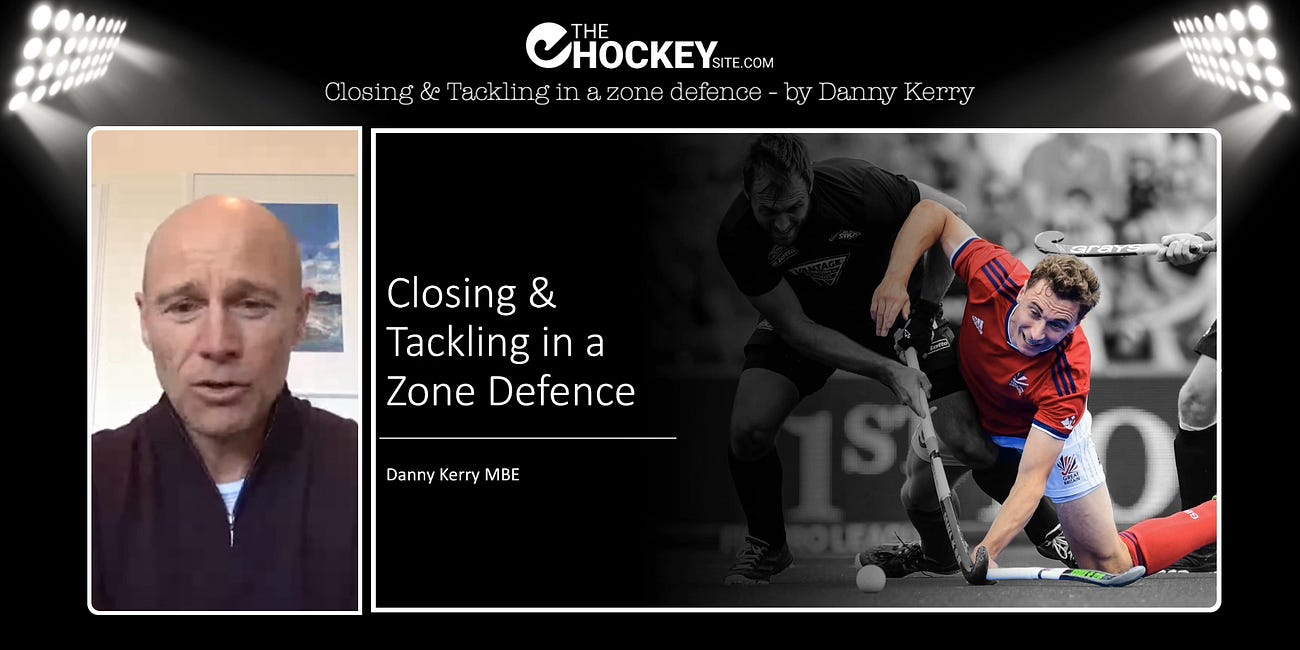If in doubt, be on the front foot and go forward in the zone
About the pros and cons of a zonal defense in the D
The zonal defense system in your own defensive circle (D) can be effective when executed well, but it comes with its own set of challenges. Let’s break this down into the key pros and cons, and then dive into how to train it effectively.
Key Pros of a Zonal Defense in Your D
Energy Efficiency: As Danny Kerry pointed out during his masterclass, a zonal system allows players to conserve energy by focusing on controlling space rather than chasing opponents. This is especially critical in high-intensity matches where physical demands are significant .
Maintains Defensive Structure: A well-organized zone ensures that your team remains compact and denies central spaces, which are the most dangerous areas for the opposition to attack. This structure forces opponents to play around the edges, reducing their chances of creating high-quality scoring opportunities .
Flexibility Against Overloads: In a zone, defenders can shift collectively to adjust to numerical overloads. This adaptability is crucial when facing teams that try to exploit mismatches or create chaos in the circle .
Encourages Collective Responsibility: Unlike man-to-man systems, where individual errors can lead to breakdowns, a zonal defense emphasizes teamwork and shared accountability. This can foster better communication and understanding among players .
Goalkeeper Integration: When goalkeepers are actively involved in managing the zone, as Kerry highlighted, they can help maintain the integrity of the defensive structure by covering aerial threats and directing defenders. This partnership can significantly enhance the effectiveness of the system .
Key Cons of a Zonal Defense in Your D
Vulnerability to Quick Passing and Skilled Opponents: Teams with strong technical skills and quick ball movement can exploit gaps in the zone, especially if the defensive structure isn’t compact enough. This requires constant vigilance and quick decision-making from defenders .
High Tactical Discipline Required: A zonal system demands excellent communication and understanding among players. If even one player fails to execute their role, it can compromise the entire structure .
Decision-Making Challenges: Players must decide when to stay in their zone and when to step out to pressure the ball. This can be particularly challenging for younger or less experienced teams .
Time-Intensive to Train: Building a cohesive zonal defense takes time and repetition. Players need to internalize principles like denying central spaces, dictating play, and disrupting opposition patterns .
How to Train a Zonal Defense in Your D
Training a zonal defense effectively requires a mix of theoretical understanding, small-sided games, and full-field practice. Here’s a step-by-step approach:
1. Teach the Principles
Start with the basics:
Deny: Take away the central spaces and force the opposition wide.
Dictate: Control where the opposition can play by positioning your players to limit their options.
Disrupt: Use pressure to break the opponent’s rhythm and force turnovers.
Dispossess: Execute tackles or interceptions to regain possession .
2. Use Small-Sided Games
Danny Kerry emphasized the value of small-sided games like 6v6 to train zonal principles. For example:
Set up a box shape with four defenders, a forward at the top, and a sweeper at the bottom.
Play against six attackers who can move freely.
Focus on maintaining the defensive shape, communicating, and applying pressure in the right moments .
3. Integrate Goalkeepers
Involve your goalkeeper in managing the zone. They should:
Communicate with defenders to maintain spacing.
Cover aerial threats and direct play from the back.
Be comfortable stepping out to support the defense when needed .
4. Practice Full-Field Scenarios
Once players understand the principles in smaller settings, transition to full-field drills. Simulate game situations where the opposition tries to overload or exploit gaps in the zone. Emphasize quick transitions between denying, dictating, and disrupting .
5. Use Video Analysis
Review game footage to highlight successes and areas for improvement. Show players examples of good zonal defense and situations where the structure broke down. This visual feedback can be invaluable for reinforcing concepts .
Final Thoughts
A zonal defense in your D can be incredibly effective if your team is disciplined, communicates well, and understands the principles behind it. However, it’s not a quick fix—it requires time, patience, and consistent training. As Danny Kerry said,
“If in doubt, be on the front foot and go forward in the zone.”
Giving players the confidence to attack within the zone, rather than collapsing backward, is key to maintaining its integrity .
If you’d like to explore this topic further or get tailored advice for your team, consider connecting with a top coach for a 1-on-1 session via Got Your Back. What challenges have you faced when implementing a zonal defense, and how have you addressed them? Let’s keep the conversation going!
Have you seen👇?
Closing and tackling in a zone defence
A masterclass by Danny Kerry (ENG) on closing & tackling in a zone defence. A topic that challenged him when he took over the English and GB national men’s team and introduced new tactics in the lead up to the Tokyo Games.





